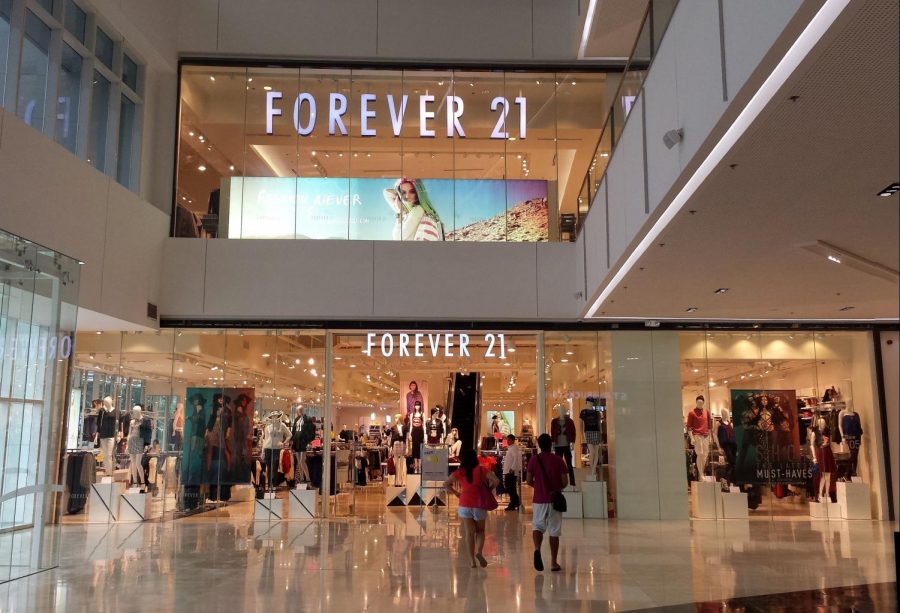“Forever 21” is a Misnomer, as the Franchise Faces an Uncertain Future
January 7, 2020
It’s ubiquitous in malls and beloved by youth and adults alike thanks to its trendy styles combined with affordable prices – but despite its name, Forever 21 might not last forever. The well-known store’s days might be numbered, as locations worldwide are shutting their doors following the company’s announcement of bankruptcy in late September.
Forever 21 became popular almost instantly when it opened its first location in Los Angeles in 1981, earning $700,000 its first year – equivalent to $2,037,811.12 in 2019. The chain’s popularity did not slow one bit. By 2015, the chain had over 480 locations in malls in the United States, with hundreds more worldwide, and was grossing $4.4 billion. However, the company did not achieve either of its goals to make $8 billion by 2017 nor open 600 new locations around the world. This led to its downfall leading to bankruptcy September 30.
In an interview with Linda Chang, the chain’s executive vice president and daughter of Don and Jin Sook Chang, the founders of the chain, published in the New York Times, it was mentioned that the chain went from selling in seven countries to 47 within less than six years—but at the same time, “the retail industry is obviously changing—there has been a softening of mall traffic and sales are shifting more to online.” The New York Times also mentioned that the company’s revenue dropped to $3.3 billion in 2017 and had 32,800 employees, far less than the 43,000 it employed in 2016. Forever 21’s website allowed for sales to remain strong, but changing consumer tastes and a rise in “fast fashion” competitors have been its most significant threats.
Forever 21 targets teenagers, millennials and middle-aged men and women; the company was named because the younger shopper base wishes to stay the ripe, fun age of 21 forever and the older shopper base desires clothes that make them feel young and hip. “40 percent of Forever 21 shoppers are between the ages of 25 and 40”, which would place them in the “millennial” sector, according to unspecified consumer studies cited in the New York Times article. The store is known for its quirky styles which add a bit of sassy flair to the trendiest looks; from a fluffy sweatshirt made of white fleece with “MILLENNIAL” written in all-caps across the front to graphic t-shirts adorned with images of tacos, burgers and fries and shiny jackets with “FORGET THE RULES” in a Gothic blackletter font on the sleeves. However, part of Forever 21’s demise lies in the fact that not only are some of their clothes so quirky and “nouveau” that some shoppers find them embarrassing and pointless, but the fact that they are no longer as “fast” and “on-trend” as they used to be, whereas other online retailers spot trends as soon as they become popular, posing a major threat to Forever 21.
With the increasing danger of climate change, consumers have also been turning their taste towards more environmentally-friendly brands which state flat-out that they are sustainable, as well as purchasing more consigned goods as to not waste resources, said Wendy Liebmann, chief executive of the consultancy WSL Strategic Retail, in an interview with the New York Times. According to the BBC, “Fast-fashion shoppers tend to buy cheap and often in order to keep up with fashion trends – but many retailers’ production methods use vast amounts of water and release chemicals into the environment.” Forever 21 is an example of these “fast fashion” brands which care more about being on-trend than environmentally-friendly.
Copyright and lawsuit issues haven’t helped Forever 21 as well; their most recent controversy of using an Ariana Grande lookalike to sell goods and misleading consumers and their history of stealing T-shirt designs from independent artists also turned some consumers off.
Though the company owes $500 million in debt, there is a possibility that they could come back—after all, bankruptcy “doesn’t always mean the end for a company,” according to Business Insider. The brand still remains strong in malls nationwide and worldwide with well over 500 locations—a large amount in comparison to other brands—and other companies have been able to revive themselves following bankruptcy. An example of such is Sbarro, the standby pizzeria in mall food courts. Originally an exclusive to food courts, Sbarro rebranded themselves as a fast casual restaurant with a new store concept. Thanks to this reimagining of the brand, it was able to open “65 U.S. locations in 2017, according to Reuters, and plans to launch many more in Asia and Russia in the next few years,” as mentioned on cheatsheet.com Forever 21 still has time to possibly restructure and come back strong, though its future remains uncertain.












